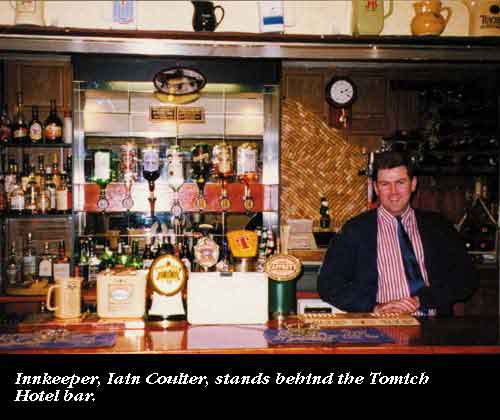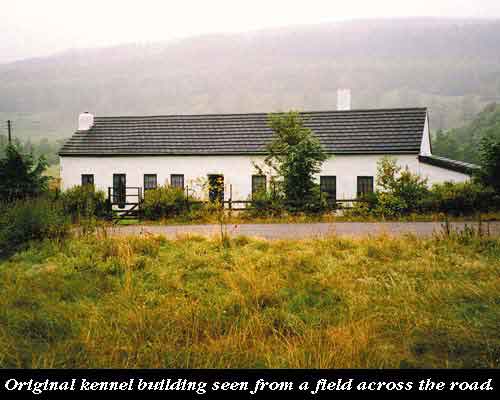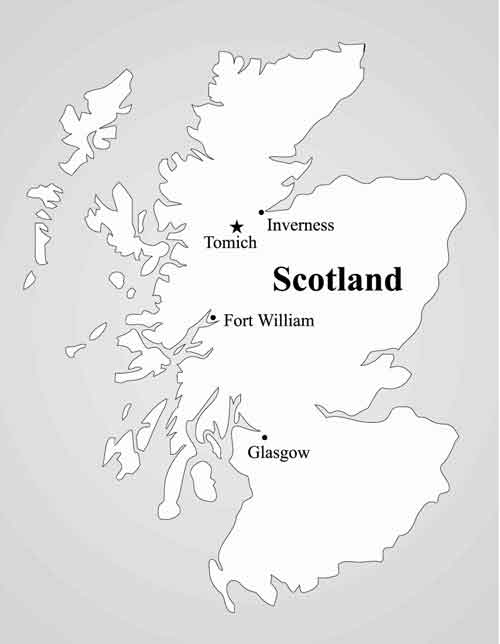The Day We Met Dileas
By Tom Rutland and Sarah Rutland

“As we left Tomich, we thought of the uniqueness of Guisachan – its isolation and its beauty – and the strength of character and purpose of the Scottish nobleman who bred the first Golden Retrievers and who could not have dreamed of how much his experiment would imprint the world of dogs, or the generations of dog fanciers who would be forever in his debt.”
The sun hid above a low, gray blanket. A light mist filled the air as we departed the inn on the eastern shore of Loch Linnhe and drove along the shoreline through Fort William, at the foot of Ben Nevis, Scotland’s tallest mountain.
We steered the rented Fiat past fields of sheep that grazed on rolling, grassy hills, along Highway A82, traveling northeastward, into the North West Highlands in search of the birthplace of the Golden Retriever breed.
About 10 miles from our destination, the road narrowed to a single lane. It wound upward through dense, enveloping forest that only occasionally yielded a glimpse of the River Affric below.
We turned south onto a road with no number, a pencil-thin gray line on our large, detailed road map. Our worries about the road quickly disappeared, however, as it proved to be hard surfaced. It was definitely “single carriageway,” or one-lane, but provided frequent turnouts where cars meeting each other could pass. Signposts pointed the way to Tomich, our destination.
We arrived there two hours after leaving Fort William. The next few hours brought us a magical, almost reverent, experience.
We found the entrance to the village marked clearly by its largest structure, the two-story Tomich Hotel, where we stopped and asked directions.


The old kennel building, the innkeeper said, lay only a quarter of a mile ahead on the right, the second-to-last structure at the edge of town. It was a white building with dark shutters and had been in use until fairly recently, but now stood vacant and was for sale. The ruins of Lord Tweedmouth’s mansion were just beyond the old kennel, and to the right when the road forked, he said.
On our way toward the old kennel building, we were delighted to see a light-colored Golden Retriever walking beside a gray-haired man and a child, and we stopped to speak. The child was his granddaughter, the man said. We asked the dog’s name and the man replied, “He is Dileas.” When we repeated his name, Dileas trotted across the road, jumped up on the side of the car and stuck his head inside to be petted. Dileas (pronounced JEE-less), we later learned, means “faithful” in Scottish Gaelic. And Dileas, owned by Hamish Ross, is Tomich’s only Golden today.


We drove on and quickly found the old kennel building. The white stucco-like structure appeared to be in good repair. A fence prevented close inspection. The immediate grounds were spacious, probably a little less than an acre.
We walked along the fence and saw as much of the building as we could. We tromped through tall, damp grass in the field across the road to take photographs.
We drove on in search of the mansion. Several minutes of driving took us past a couple of occupied residences, but we failed to find the mansion. It surely was not within easy walking distance from the kennel building, as we thought.
We returned to Tomich and stopped first at a large stone monument with a semicircular stone horse trough and fountain. The inscription read:
“To the memory of Sir Dudley Coutts Marjoribanks Bart: 1st Lord Tweedmouth. Born Dec. 29, 1820, Died Mar. 4, 1894, whose home was at Guisachan 1854-1894 who built the village of Tomich and whose chief delight was to work for the improvement and development of this district and also to the memory of Isabel Lady Tweedmouth who was as a mother to the people on the Guisachan property from 1854 to 1905. This fountain is erected by their children Edward 2nd Lord Tweedmouth and Ishbel Countess of Aberdeen.”


Above the monument is the inscription “Advantage with Courage.” The right side bore a sculpted portrait of Lord Tweedmouth, the left side Lady Tweedmouth’s likeness. A sculpted canine head is just beneath each portrait.
A few hundred yards farther on we stopped at the post office, just across from the hotel, to again seek different directions to the mansion.
nside we found a charming lady who answered several of our questions, then picked up the telephone and dialed. “There’s someone here about the Golden Retrievers,” she said to the person on the other end. “Do you want to talk to them?”
Sarah found herself talking with Col. James Fraser, who had purchased Guisachan, the remains of the Tweedmouth estate, in 1966. He gave us more specific directions to the mansion. (Guisachan is pronounced KUSH-g’n. The accent is on the first syllable, which rhymes with push. The second syllable sounds like the ending of Michigan, and the word is pronounced quickly, in a clipped manner.
Later that morning, we learned that the postmistress was Christina MacDonald, fondly known as Mulaidh, Gaelic for “darling.” Mulaidh (pronounced MU-lee) is in her late 80s. She and her family ran the Tomich Hotel for many years. She opened the post office in 1937 and has run it ever since.
Recently, Queen Elizabeth II awarded Mulaidh the title MBE – Member, Order of the British Empire – to honor her 61 years as postmistress. The Queen was scheduled to send an emissary to present the award in Tomich, since Mulaidh’s health prevented her from traveling to London, the innkeeper said.
We set off again for the mansion. Still, we did not readily find the ruins. But finally, as we drove further, we went up a hill and around a gentle bend in the road and came upon the crumbling but still grand house.


As we walked all around the majestic mansion ruins atop a grassy hill, and looked out over lush meadows, it was easy to imagine the grand lifestyle of Lord Tweedmouth and how this noble sportsman and his friends had hunted with his Goldens across the surrounding countryside.
Part of the pleasure of the moment was seeing the birthplace of our breed. Part was simply the serenity and beauty of Guisachan and the whole experience of Scotland.
This is an ancient country immersed in colorful, proud history, whose principal industry today is tourism. A visitor from the United States quickly appreciates the absence of advertising billboards and, indeed, signs of any kind other than road markers. There is solitude all around outside the cities, and the northwest region is particularly sparsely populated. At Tomich and Guisachan, 45 minutes from Inverness, we felt almost removed from modern civilization. In the village there is no grocery store, no gasoline station, no video rental. It is remote and classically rural.
Guisachan goes back much further than Lord Tweedmouth. Members of the Frasers of Culbokie owned and resided at Guisachan estate from the 16th century, probably the year 1520.
A lengthy succession of resident Frasers is recounted in Donald Fraser’s self-published book, Guisachan – A History. Donald Fraser, a local farmer, is among the current owners of Guisachan House and sole owner of Tomich Hotel. He is the son of Col. James Fraser, with whom we spoke.
But it was Lord Tweedmouth who developed Guisachan to its glory after he purchased the estate in 1854. He was an avid hunter and often would visit the owners of this grand estate. It is said that Sir Dudley Marjoribanks, subsequently known as Lord Tweedmouth, was at a dinner party at Guisachan. The man (a Fraser) who was hosting the dinner said, “If anyone gave me 60,000 pounds for Guisachan I would sell it tomorrow.” “Done!” came a voice from the end of the table. Although the owner approached Lord Tweedmouth the next day and told him he had not been serious about the offer, Lord Tweedmouth insisted “a gentleman’s word is his bond” – and the sale was completed.
Lord Tweedmouth set about building a palatial home and a residential community to provide support. Within a few years he had built Guisachan House, the mansion; new farms; a dairy; the model town of Tomich; kennels; stables for the riding horses; a laundry; a brewery; a mill to make meal; a school; and other lodges and dwellings.
The farm became well known for its purebred cattle, Highland and Aberdeen Angus, and for its Highland ponies, which were crossed with a Thoroughbred sire to produce good riding horses for guests at the mansion.

“And finally there were his dogs,” Fraser wrote, quoting Lord Tweedmouth’s daughter Ishbel: “In addition to the Golden Retrievers – there were pointers, celebrated for their prowess on the grouse moor, his favorite deer hounds, and last but not least, his little Cairn terriers.”
The origin of the Golden Retriever is not as obscure as most other breeds of dogs. We know the breed definitely was begun by Lord Tweedmouth, as shown in his private stud book and notes, first brought to light by his great-nephew in 1952. In 1868, Lord Tweedmouth mated a yellow Wavy-Coated Retriever (“Nous”) he had purchased from a cobbler to a Tweed Water Spaniel (“Belle”). These Tweed Water Spaniels were said to be rare except in the Border Country. They looked like a small retriever, liver-colored and curly-coated. Tweedmouth methodically linebred down from this mating using another Tweed Water Spaniel and outcrosses of two black retrievers, an Irish Setter, and a sandy-colored Bloodhound. He had finally bred the hunting dog he so loved and the dog we have grown to love.
Lord Tweedmouth was a member of Gladstone’s government, and during the annual six-month parliamentary recess many famous and influential people visited the family at Guisachan. In 1897 the Duke and Duchess of York, who later became George V and Queen Mary, stayed there as guests of the Tweedmouths.
In 1873, Lord Tweedmouth’s son, Edward, married Fanny Spencer Churchill, daughter of the Duke and Duchess of Marlborough and sister of Lord Randolph Churchill. Fanny’s nephew, Winston Churchill, spent holidays at Guisachan and learned to drive a car there.
Lord Tweedmouth died in 1894, and his widow in 1905.
After Fanny, the second Lady Tweedmouth, died in 1904, Edward suffered financial losses and declining health. He was forced to sell Guisachan in 1908. He died the following year. His estate, however, retained “Tomich House,” now the Tomich Hotel.
The Tweedmouth line ended with Edward’s son, Dudley Churchill Marjoribanks, who became 3rd Lord Tweedmouth in 1909. He and his wife had two daughters, but no male heir. For the next 27 years, the estate was owned by Lord Portsmouth’s family. The property, then consisting of 22,000 acres (more than 34 square miles), was sold in 1935 to a Mr. Hunter, who resold the deer forest to the west and a large area of grazing land to the Forestry Commission. All efforts to sell Guisachan House failed. It was said that its 15 family rooms and 16 servants rooms were too many, and its five bathrooms too few. In spite of a price tag of £3,500 for the mansion standing on 150 acres, no purchaser could be found.
In 1937, Ishbel, now Lady Aberdeen, the daughter who was responsible for erecting the monument to her parents, once again used her influence to persuade the Northern Regional Committee of the National Fitness Campaign to rent it as a training center for young leaders. In 1938 it became the first Keep Fit Summer School in Britain. The training offered for men was in athletics, gymnastics, boxing, Highland dancing and minor games. Women received exercise games and dancing lessons.
The end of the mansion came in 1939 when a Lady Islington purchased the house for £1,500 and began to strip it in preparation for demolition.



Meanwhile, the estate was split up and sold. This was disastrous for sporting-minded people because the forest fences segregated the hill ground from wintering and gave the deer no shelter. This caused the deer to overgraze the hill ground. The remainder of the estate – the “home farm” and a small part of the hill above it, now known as Guisachan – was sold to Michael Waddel after World War II. Mr. Waddel died in 1960 with no heirs.
In 1961 the estate was again placed on the market. Euan Fraser bought it. Finally, and after 107 years, the estate was once again in the hands of the Frasers. Part of the estate is now owned by Col. James Fraser’s younger son, Donald.
Margaret Baumont purchased the kennel building, located about three-quarters of a mile down the hill from the mansion house, restored it, and for a while operated a bed-and-breakfast there. It later was closed and, at the time of our visit, was for sale for approximately £150,000 ($247,000). It reportedly was sold in November 1998. We were unable to learn the identity of the buyer.
Before leaving Tomich, we ate lunch at the Tomich Hotel, where we enjoyed a cordial visit with the innkeeper, Iain Coulter. Coulter and his partner, Elaine MacDonald, run a spotless, charming hotel with seven guestrooms.
As the fireplace in the cozy bar warmed us from the damp chill outside, we discovered two large pictures in the short hall leading to the dining room. The pictures showed the floor plans of the Tweedmouth mansion.
As we ate our hot soup and freshly made sandwiches, Coulter told us that Tomich has about 100 residents, mostly retirees. A few folk work in Inverness, about 45 minutes to the north, where Tomich residents shop for groceries and other necessities.
The Tomich Hotel is almost completely booked from March through November each year for various sporting activities. In winter, the temperature sometimes reaches 10 degrees below zero, but lows normally hover around the freezing mark, with very little snow because it lies in a valley.
As we left Tomich, we thought of the uniqueness of Guisachan – its isolation and its beauty – and the strength of character and purpose of the Scottish nobleman who bred the first Golden Retrievers and who could not have dreamed of how much his experiment would imprint the world of dogs, or the generations of dog fanciers who would be forever in his debt.
Inverness lies due north of Glasgow, on the North Sea coast at the tip of Moray Firth. Just below Inverness, the famed Loch Ness extends southwestward like a long, skinny finger. Highway A831 runs from the little town of Beauly, west of Inverness, southwest to Cannich, and from Cannich due east to Drumnadrochit and A82, a major highway that runs along the west side of Loch Ness. Tomich lies below Cannich.
Guisachan – A History by Donald Fraser, was a source for some of the historical material recounted in this article.
Interested readers may contact the authors at srutla1@c-com.net
